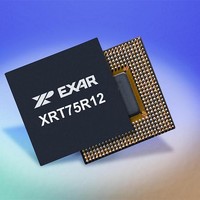XRT75R12DIB-F Exar Corporation, XRT75R12DIB-F Datasheet - Page 101

XRT75R12DIB-F
Manufacturer Part Number
XRT75R12DIB-F
Description
Peripheral Drivers & Components (PCIs) 12 Channel 3.3V-5V temp -45 to 85C
Manufacturer
Exar Corporation
Datasheet
1.XRT75R12DIB-F.pdf
(133 pages)
Specifications of XRT75R12DIB-F
Maximum Operating Temperature
+ 85 C
Minimum Operating Temperature
- 40 C
Mounting Style
SMD/SMT
Operating Supply Voltage
3.3 V to 5 V
Package / Case
TBGA-420
Lead Free Status / RoHS Status
Lead free / RoHS Compliant
- Current page: 101 of 133
- Download datasheet (851Kb)
REV. 1.0.3
Throughout each of these cases, we will discuss how the resulting "bit-stuffing" (that was done when mapping
the DS3 signal into SONET) affects the amount of intrinsic jitter and wander that will be present in the DS3
signal, once it is ultimately de-mapped from SONET.
Let us assume that we are mapping a DS3 signal, which has a bit rate of exactly 44.736Mbps (with no
frequency offset) into SONET. Further, let us assume that the SONET circuitry within the PTE is clocked at
exactly 51.84MHz (also with no frequency offset), as depicted below.
Given the above-mentioned assumptions, we can state the following.
Is there a Problem?
According to
bits". In this case, each STS-1 SPE appears to be three bits "short".
No there is a Simple Solution
three additional bits (for DS3 data) are obtained by using three of these "Stuff Opportunity" bits. As a
consequence, three (3) of these nine (9) "Stuff Opportunity" bits, within each STS-1 SPE, will carry DS3 data-
bits. The remaining six (6) "Stuff Opportunity" bits will typically function as "stuff" bits.
In summary, for the "Ideal Case"; where there is no frequency offset between the DS3 and the STS-1 bit-rates,
once this DS3 data-stream has been mapped into the STS-1 data-stream, then each and every STS-1 SPE will
have the following "Stuff Opportunity" bit utilization.
3 "Stuff Opportunity" bits will carry DS3 data bits.
6 "Stuff Opportunity" bits will function as "stuff" bits
F
No, earlier we mentioned that each STS-1 SPE consists of nine (9) "Stuff Opportunity" bits. Therefore, these
8.2.2.1
IGURE
The Ideal Case (e.g., with no frequency offsets)
The 44.736Mbps + 1 ppm Case
The 44.736MHz - 1ppm Case
The DS3 data-stream has a bit-rate of exactly 44.736Mbps
The PTE will create 8000 STS-1 SPE's per second
In order to properly map a DS3 data-stream into an STS-1 data-stream, then each STS-1 SPE must carry
(44.736Mbps/8000 =) 5592 DS3 data bits.
45. A S
TWELVE CHANNEL E3/DS3/STS-1 LINE INTERFACE UNIT WITH SONET DESYNCHRONIZER
Figure
The Ideal Case for Mapping DS3 data into an STS-1 Signal (e.g., with no Frequency
Offsets)
IMPLE
44.736MHz + 0ppm
44, each STS-1 SPE only contains 5589 bits that are specifically designated for "DS3 data
I
LLUSTRATION OF A
DS3_Data_In
DS3 D
ATA
-S
PTE
PTE
97
TREAM BEING
M
APPED INTO AN
STS-1_Data_Out
51.84MHz + 0ppm
STS-1 SPE,
XRT75R12D
VIA A
PTE
Related parts for XRT75R12DIB-F
Image
Part Number
Description
Manufacturer
Datasheet
Request
R

Part Number:
Description:
Twelve Channel E3/ds3/sts-1 Line Interface Unit With Jitter
Manufacturer:
Exar Corporation
Datasheet:

Part Number:
Description:
BiCMOS Fixed, Quad, Voltage Output, Single or Dual Supply 8-Bit Digital-to-Analog Converter
Manufacturer:
Exar Corporation
Datasheet:

Part Number:
Description:
Manufacturer:
Exar Corporation
Datasheet:

Part Number:
Description:
Voltage-Controlled Oscillator
Manufacturer:
Exar Corporation
Datasheet:

Part Number:
Description:
INTEGRATED LINE TRANSMITTER
Manufacturer:
Exar Corporation
Datasheet:

Part Number:
Description:
Monolithic Function Generator
Manufacturer:
Exar Corporation
Datasheet:

Part Number:
Description:
CMOS Microprocessor Compatible Double-Buffered 12-Bit Digital-to-Analog Converter
Manufacturer:
Exar Corporation
Datasheet:

Part Number:
Description:
CMOS 6 BIT HIGH SPEED ANALOG TO DIGITAL CONVERTER
Manufacturer:
Exar Corporation
Datasheet:

Part Number:
Description:
Manufacturer:
Exar Corporation
Datasheet:

Part Number:
Description:
Manufacturer:
Exar Corporation
Datasheet:

Part Number:
Description:
8-Channel, Voltage Output 10 MHz Input Bandwidth 8-Bit Multiplying DACs with Serial Digital Data Por
Manufacturer:
Exar Corporation
Datasheet:

Part Number:
Description:
15 V CMOS Multiplying10-Bit Digital-to-Analog Converter
Manufacturer:
Exar Corporation
Datasheet:

Part Number:
Description:
Monolithic Function Generator
Manufacturer:
Exar Corporation
Datasheet:










